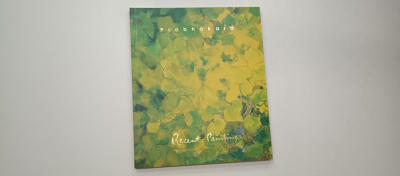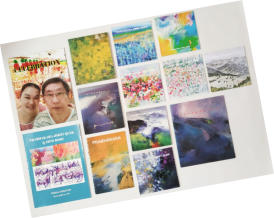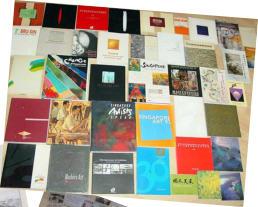Recent Paintings by Prabhakara Jimmy Quek
By Constance Sheares
Despite his urban roots, Prabhakara Jimmy Quek has always been
fascinated by the countryside. His earliest paintings are bird's-eye views
of agricultural land, which have the functional look of modern design.
Here and there the pattern of fields is broken by lines of canals, roads
or a meandering river. Tranquillity, 1987 (Collection: Shell Companies
in Singapore), is an example of such panoramic vistas of patchwork
fields and high horizons-clean and straight-forward, lucid and
informative.
Prabhakara's early enthusiasm for art was encouraged by Tan Seng
Yong, his art teacher at Dunman Government Chinese Middle School,
who taught him Chinese painting, calligraphy, watercolours and oil
painting, and took him to exhibitions. A minor impediment caused by a
childhood bout with polio was also a factor in fostering his interest in
the relatively sedentary occupation of painting. On leaving school in
1973, he enrolled in the Nanyang Academy of Fine Arts where he
received lessons from Si Xiangtuo, Chen Chong Swee and Lim Yew
Kuan, among others. He left after only a year, persuaded by his father
to take a course in business studies at the Ngee Ann Technical College,
where he was enrolled from 1974 to 1977. He then worked for six years
as an administrative officer, then accounts executive, and finally
manager in a design company where his artistic flair proved in graphic
and three-dimensional design projects.
In 1985 Prabhakara gave up all business involvement in order to
concentrate on painting, starting with a refresher course at St Patrick's
School of Art (now known as La Salle College of the Arts). "Steffan
Neumann, a Belgian artist lecturing there, taught me the colour theory
which I then began applying in my painting. But I left after two year, as I
soon picked up what I wanted to learn and had my own ideas about
art, I had my first solo exhibition in 1987.
Eager to be involved in the most avant-garde in art, Prabhakara
developed an image of landscape in which nature is portrayed in all its
pristine wildness, very different from his lucid and informative aerial
views of nature, tamed and ordered by the human hand. Implicit in
these painting is the notion of the sublime in nature, where the natural
world is portrayed as picturesque and beautiful on the one hand, and
terrifying and powerful on the other.
Prabhakara's focus on nature's abstract elements, never-stable and
ever-changing, led him to an art in which the recognizable object
ultimately disappears. He achieved this by combining the techniques
he had learned with his enthusiasm for American Expressionism,
taking risks with his material to create a powerful physical sense of the
outdoors and of the atmosphere and coastline, the winds and
rainstorms. The best known from this series are Beginning to Rejoice
and Celebrating with Nature, 1992 (Collection: Raffles City Pte Ltd,
displayed in the foyer of the Westin Stamford), monumental vistas
painted with a sweeping brush and dramatic colours to convey the
artist's profound feeling for the mysteries of nature and immensity of
the universe.
"Nature, especially natural phenomena such as the infinitely changing
aspects of water and light in waves, clouds, the sky - these are the
subjects I like to paint..... When painting, I find my feelings and
perceptions fit in well with the strong Buddhist beliefs I have had since
young. Constant change, impermanence and non-self, the overall
scheme of thing where everything has its place and yet relates and
interacts with all other things. These are what I try to depict in my
paintings", Prabhakara stated in 1990. By then he had become a devout
Buddhist, spending part of each year meditating in a forest retreat.
After his exhibition in 1987, he had visited India, Nepal and Kashmir in
order to make a pilgrimage to the four sacred Buddhist sites - the
places of his birth, enlightenment, first discourse and death. Besides
panoramic landscapes of even greater breadth and grandeur, this had
resulted in a series of abstract paintings composed of irregular
rectangles, like paving stones, in colours borrowed from ancient Indian
temples and traditional textiles.
On his return from India, Prabhakara spent ten days at
Santisukharama, a Buddhist Meditation Center in Kota Tinggi, Malaysia,
practising the art of meditation under the guidance of the Venerable
Sujiva. The Buddhist idea of enlightenment and preoccupied him since
the early 1980s. He associated it with his own objective of shedding his
egotism as well as all unwise desires. Reading extensively the
publications on Buddhism by such scholars and teachers as Jack
Kornfield, Sayadaw U Pandita and the Venerable U Silananda, he found
himself thinking of imagery as a metaphor like language, able to
explain a concept. In 1988 he began a series of paintings dealing not so
much with moving figures as with movement itself, such as
Impression, 1988 (Collection: Singapore Art Museum). This tendency
culminates in Dance of Change, 1992, in which concrete subject
matter is absent. Resembling diaphanous veils of smoke wafting in the
wind, gentle ripples of water or the blurred images of moving figures
caught in photographs, these paintings with their flowing patterns and
tonal colors are the artist's visual interpretations of the Buddhist law of
impermanence and changeability.
"You see impermanence in everything. And with this understanding, I
feel I can do better paintings...... sometimes I might be satisfied with
something I have done. Later, when I look at it again, I might feel like
changing certain things. I dare to do it because everything is subject to
change. There's always a lot of unlimited creative energy", Prabhakara
stated, explaining his desire to paint pictures that could express the
liberation that results from the loss of ego, the ridding of an exclusive
identity or self, to be replaced by the sense of interrelation and
interdependence. Through these paintings he hopes to gain an insight
into the meaning of his own existence and to demonstrate his
acceptance of things they are. For he realizes that the striving for
enlightenment is in itself a paradox because it is this desire and this
striving that he should be rid of.
His idea of these "insights" is embodied in the Trees series, inspired by
the rubber plantations surrounding the Buddhist retreat in Kota Tinggi.
The idea of painting trees came to him in 1987 but was not executed
until 1991. Early works, such as Quiet Plantation, 1991, are relatively
realistically conceived, but by the following year he had progressed to a
more abstract approach, as in Mystic Memory, 1992, in which
calligraphy makes its first appearance, albeit in pretend form. His
intention was to paint the essence of the trees, their sound and feel
rather than their physical reality. The artist, alone in the forest,
becomes aware only of nature's beauty and its unpredictability, hearing
the sounds and feeling the emotions, which cannot be heard or felt in
the city. These paintings pay homage to Cezanne and Picasso but are
essentially about the fundamentals of people's relationship with
nature, about a state of mind.
Abstraction is taken a step forward in May You Be Well and Happy I,
1996, by the addition of the Buddhist injunction "May you be well and
happy", Imagein Chinese and English, over and over again on the
painting. This has the effect of bringing the pattern of trees right on the
picture surface, flattening them even further. In Going for Retreat II,
1997, similar inscriptions, combined with graffiti-like drawings of
Buddha images and other symbols, are scrawled over almost the entire
painting. Explaining his intentions, Prabhakara states, " I practice
Vipassana whereby one becomes acutely aware of one's body
movements, feelings and thoughts. When one listens, one is also aware
of listening. This applies to everything one does. It is a process of
knowing the cause and effect of all phenomena. That is how wisdom
and understanding is achieved. Concentration gives one peace and a
calm mind. Steadfast mindfulness leads to the purification of the mind,
enabling one to overcome worries and pain. This is Buddha's teaching,
and painting is my way of sharing this experience."
In the early 1990s, paintings containing obvious landscape references
gradually gave way to those with more symbolic imagery, such as the
Games series. Like the Trees series, this is meant as a metaphor for the
process of losing one's ego, when the mind becomes void of all
thoughts, all desires. Begun in 1994 and based on horizontal and
vertical lines, the symbols of tabulated good order, these pictures of
chessboards, and other game boards are given personal meaning and
an atmosphere or some kind of mood. "Games, like Chinese chess,
snake and ladders and tic-tac-toe, are linked with childhood
memories... Life is like a game. Whether you go up or down, win or
lose, is all due to many circumstances. What is important is to "play"
with mindfulness, to look beyond the winning and the losing, to enjoy
each step. Suddenly the game is over and you begin all over again."
In Chessboard: Missing Square, 1994, Prabhakara pares down the
elements of his picture making to squares in atmospheric blues and
greys. He has a special way of coming simplicity of style and subject
matter with subtlety of perception to convey a sense of unchanging
time, inevitability or eternity. Whereas Snakes and Ladders, 1994, is an
almost literal visual translation of that well-known game board, Game
of Satipatthana, begun in 1994 and completed in 1997, adopts a more
abstractionist approach to content of an obscure and personal nature.
Signs and symbols intermingle with the snakes and ladders, altering
their meaning, function and symbolic value.
The Wisdom series runs concurrently with the Games series to which it
is closely related, compositionally and conceptually. Sheng Sheng
Sheng Si Sheng, 1994, was inspired by Thich Nhat Hanh's poem which
is a repetition of only two Chinese characters, Sheng (meaning "life" or
Image"to be born") and Si (meaning "death" or "to die"), arranged in
such a way as to mean, "During many lifetimes, birth and death are
present, / giving rise to birth and death./ The moment the notion of
birth and death arises, / birth and death are there./ As soon as the
notion of birth and death dies, / real life is born." The painting is
divided vertically into two equal halves by means of a line of the
ancient lock or key motif used by the artist to symbolize the inseverable
link between life and death. The poem in its original Chinese, as well as
its English translation, is inscribed all over the textured surface of the
painting, like graffiti on an old, stained wall.
Wisdom: There is no fire..., 1996, consists simply of coloured squares,
so thickly layered with paint that the inscriptions are literally engraved
in it. Concentration on the text of these inscriptions forms part of the
meditation process. The artist is trying to convey that sense of purity, of
nothingness, reached in meditation when all consciousness dissolves
with the realization of the transience of all life and all matter. In
Wisdom: We are What..., 1996, the squares are replaced by bands of
lettering in similar pastel hues.
Prabhakara explained the difference between these symbolistic works
and the earlier expressionistic ones, "In the past my desires made me
do many things in a restless state of mind, but now I know my
thoughts. This helps in my painting. Now I paint only when I feel the
conditions are right I allow my ideas and inspiration to mature before I
begin. I see myself more clearly and am able to develop a state of
mindfulness and joy.
From time to time, Prabhakara breaks away from imagery drawn from
Buddhist iconography and from the imagination in order to paint
directly observed scenes of everyday life. These are usually small
outdoor genre or interior scenes in the manner of Bonnard, such as
Merry Go Round, 1995, and Pannajiva's Stroller, 1996. They have the
appearance of spontaneity and some may have been executed en plein
air, but are in fact carefully composed, using detailed preparatory
drawings, a few dating to 1985-86.
Prabhakara's search for truth in nature focused on what could be
considered the most beautiful creation of nature - flowers. Love of
flowers and the spiritual value attached to them is deeply rooted in
every religion and all people. They are synonymous with feelings of
love and joy, sentiments of nostalgia and dreams. The recent
Bougainvillea series comprises some of the brightest pictures that
Prabhakara has ever done, packed with pigment, and laden with the
earnestness of his observation - direct and objective. Rejoicing, 1997,
is a poetic image of joy, offering the prospect of a totally agreeable,
happy experience. It reflects the artist's mood of buoyancy and
confidence at the time. The ego is engulfed by the splendour of the
natural world, here symbolized by the brilliant red and pink blooms.
Like Monet's late Waterlilies, its simple composition and close-up view-
point is a parallel to a situation where the ego has dissolved and all is
one and one is all. The artist is trying to tell us that enlightenment just
comes, quite unexpectedly - It just happens.
Prabhakara's most recent works are a series of metaphysical paintings
prompted by his reading from the poems and commentaries of
Buddhist scholars and spiritual leaders. Body and Mind, 1997, depicts
the four material elements and the five aggregates or Image"mind" and
"body" which make up the essence of meditation. The four elements -
earth, water, fire and air - are represented by the four snakes, whiles
the five aggregates - matter, feeling, perception, mental activity and
consciousness - are represented by five mask-like figures, ranged one
behind the other. The sixth figure, looming threateningly in black and
bearing two swords, symbolizes desire, the insidious robber of
equanimity and the stumbling block in the path to Nirvana.
The artist's search for greater spiritual contact with landscape drew
him to the landmarks of Buddhist India. The mysteries shrouding the
ancient sites are like keys to a lost language that can reveal mystical
truths. Night Conversation, 1997, was inspired by the Venerable
Sujiva's explanation of Sutta 19 of the Buddha's Discourses which
elaborates on Buddha's conversation with Brahma when he was
residing on Vultures' Peak in Rajagaha. In this dark painting the single
light shining from the mountain peak represents the light of the
Buddha illuminating the path to enlightenment.
Victory, 1997 was inspired by the Jataka story of the Buddha subduing
the rampant elephant, Nalagiri. The preparatory sketches were derived
from a drawing by Nguyen Thi Hop, reproduced in a book recounting
this story, but the final painting is quite different from this drawing. The
figures of the Buddha and the elephant are fragmented and then
merged into an abstract composition executed in bold and expressive
strokes of black, deep blues and greys. Somehow, the painting
manages to convey an impression of a whole sequence of actions - the
elephant charging up in rage, the Buddha raising his hand to stroke its
head, and the elephant kneeling in submission. There is here a strength
and monumentality missing in the earlier paintings on the theme of
movement and change to which it is evidently related.
Thich Nhat Hanh's poem about his brother's return home after a long
journey formed the basis of Smiles and Tears, 1997, a mystical picture
full of Buddhist symbols, such as the lotus and the flaming mountain. It
has obvious links with his earlier paintings about change and
impermanence but is intended to capture and evoke a mood of
contemplation.
In Union, 1997, there is a reductive tendency, a simplification, for the
sake of visual and emotional impact. There is no consistency in the
perspective but a homogenous blue tonality unifies the transparent,
barely defined foreground figure with the illusionistically painted
landscape. This indistinct figure functions as a self-portrait, set in a
mental landscape in which the physical and the spiritual co-exist. The
artist is portraying himself in the psychological and physical condition
of a yogi in his quest for freedom from material desires, for a spiritual
life, peace and hope.
Begin Again Today, 1997, was inspired by a dream vision of the four
Buddhist spiritual leaders who had most influenced the artist -
Sayadaw U Pandita and his disciple the Venerable Sujiva, Sayadaw U
Rajinda and Sayadaw U Nanapunnika. Prabhakara has reduced and
simplified the figures to mere silhouettes, enveloping them in a haze of
incense smoke through which an ethereal, golden light shines., He rubs
out, paints over and glazes till the canvas acquires the incandescence
of a Redon. There is in this painting an overwhelming sense of the
spiritual achieved by a unique combination of fact and fantasy.
In another version, entitled Witnessing the Great Phenomenon,
1997, Prabhakara depicts the four monks experiencing a vision of
Nirvana. The figures stand waist deep in a field of flowers stretching
into the horizon, silhouette against a sky of multicoloured stars. The
pointillist technique is used here to convey the impression of an
explosion of fireworks and blossoms. The figures are painted in
shorthand with minimal identifying features, yet must function as
portraits. This is a memorial picture in which the sense of wondrous
happening is achieved by exaggerating the floral pattern and the
surreal colours. For the artist, flowers are permanently associated with
joy.
Prabhakara's study of the Buddhist texts has given him the courage to
change his style to using heavier brushwork without the fierce
spontaneity associated with his expressionistic landscapes. It has also
supplied him with a great stock of symbolic images and a feeling for
the subconscious in which the past and the present are united. For
him, the dream, that ambiguous state between imagination and reality,
has now become the source of "true" experience and therefore true
creativity. He now brushes in suggestions of images and gradually
builds up his pictures with layers of paint to achieve the ethereal
luminosity of a dream vision. He works on many canvases at once, but
feels free to leave any unfinished, to be completed, at a later time.
There is now no tendency to force any through to a final conclusion,
the image of each being allowed to crystallize out of a matrix of various
possibility. For this forty-two-year-old artist, after a sustained practice
of fifteen years, painting has become introspective and
autobiographical, a sort of writing on canvas in which can be read the
state of his mind and which expresses his inner character, his sense of
continual change, of hope and joy.
October 1997.
Constance Sheares received a Bachelor of Arts (Honours) degree in European Art History from
the Courtauld Institute, University of London, in 1966, and a Master of Arts degree in Asian Art
History from the University of Singapore in 1970. As the National Museum’s Curator of
Anthropology (1971-73). Curator of Southeast Asian Ethnology (1982-85) and Curator of Art
(1973-76, 1985-88). She was responsible for a large number of art and ethnological exhibitions.
She is a member of the Singapore Art Museum’s Acquisition and Exhibition Committee and the
Instana Art Committee and chairperson at the Singapore Arts Centre’s Art Advisory Panel. Her
most recent appointment is that of Curator of the Ng Eng Teng Gallery, National University of
Singapore.
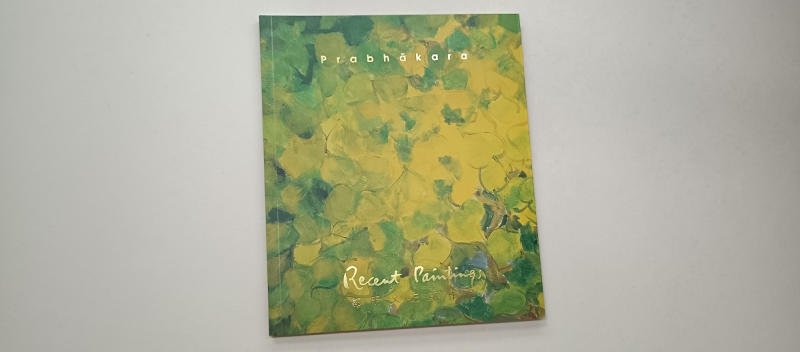
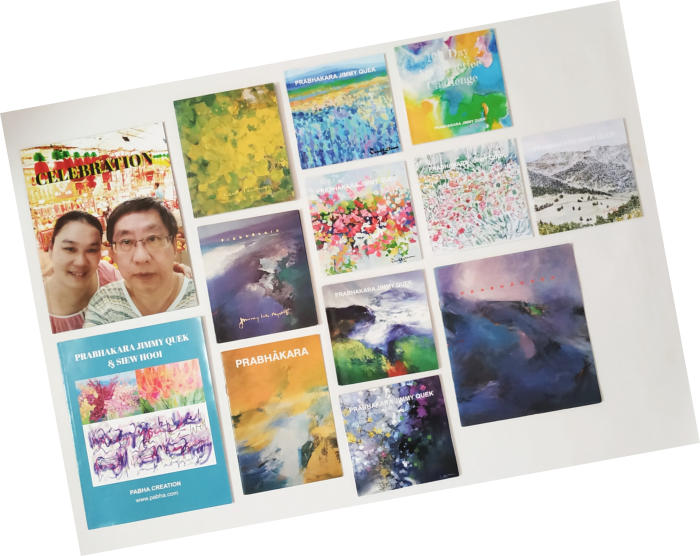
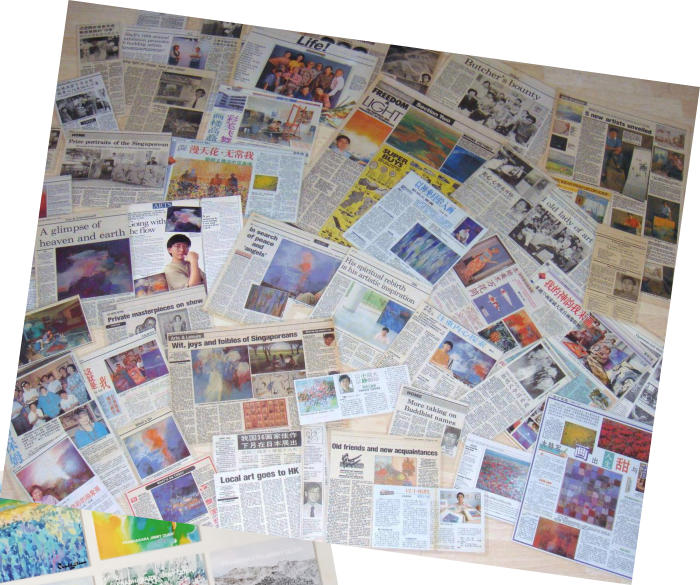
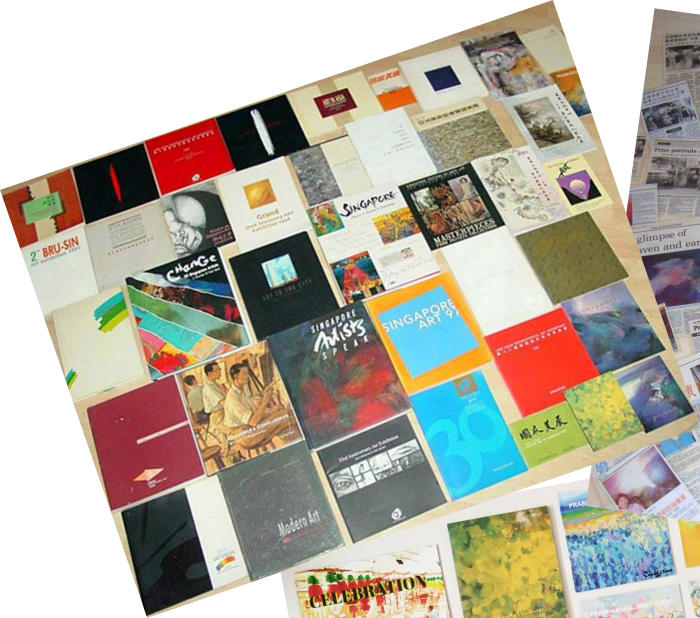


Recent Paintings by Prabhakara
Jimmy Quek
By Constance Sheares
Despite his urban roots, Prabhakara Jimmy
Quek has always been fascinated by the
countryside. His earliest paintings are bird's-eye
views of agricultural land, which have the
functional look of modern design. Here and
there the pattern of fields is broken by lines of
canals, roads or a meandering river.
Tranquillity, 1987 (Collection: Shell Companies
in Singapore), is an example of such panoramic
vistas of patchwork fields and high horizons-
clean and straight-forward, lucid and
informative.
Prabhakara's early enthusiasm for art was
encouraged by Tan Seng Yong, his art teacher
at Dunman Government Chinese Middle
School, who taught him Chinese painting,
calligraphy, watercolours and oil painting, and
took him to exhibitions. A minor impediment
caused by a childhood bout with polio was also
a factor in fostering his interest in the relatively
sedentary occupation of painting. On leaving
school in 1973, he enrolled in the Nanyang
Academy of Fine Arts where he received
lessons from Si Xiangtuo, Chen Chong Swee
and Lim Yew Kuan, among others. He left after
only a year, persuaded by his father to take a
course in business studies at the Ngee Ann
Technical College, where he was enrolled from
1974 to 1977. He then worked for six years as
an administrative officer, then accounts
executive, and finally manager in a design
company where his artistic flair proved in
graphic and three-dimensional design projects.
In 1985 Prabhakara gave up all business
involvement in order to concentrate on
painting, starting with a refresher course at St
Patrick's School of Art (now known as La Salle
College of the Arts). "Steffan Neumann, a
Belgian artist lecturing there, taught me the
colour theory which I then began applying in
my painting. But I left after two year, as I soon
picked up what I wanted to learn and had my
own ideas about art, I had my first solo
exhibition in 1987.
Eager to be involved in the most avant-garde in
art, Prabhakara developed an image of
landscape in which nature is portrayed in all its
pristine wildness, very different from his lucid
and informative aerial views of nature, tamed
and ordered by the human hand. Implicit in
these painting is the notion of the sublime in
nature, where the natural world is portrayed as
picturesque and beautiful on the one hand,
and terrifying and powerful on the other.
Prabhakara's focus on nature's abstract
elements, never-stable and ever-changing, led
him to an art in which the recognizable object
ultimately disappears. He achieved this by
combining the techniques he had learned with
his enthusiasm for American Expressionism,
taking risks with his material to create a
powerful physical sense of the outdoors and of
the atmosphere and coastline, the winds and
rainstorms. The best known from this series
are Beginning to Rejoice and Celebrating
with Nature, 1992 (Collection: Raffles City Pte
Ltd, displayed in the foyer of the Westin
Stamford), monumental vistas painted with a
sweeping brush and dramatic colours to
convey the artist's profound feeling for the
mysteries of nature and immensity of the
universe.
"Nature, especially natural phenomena such as
the infinitely changing aspects of water and
light in waves, clouds, the sky - these are the
subjects I like to paint..... When painting, I find
my feelings and perceptions fit in well with the
strong Buddhist beliefs I have had since young.
Constant change, impermanence and non-self,
the overall scheme of thing where everything
has its place and yet relates and interacts with
all other things. These are what I try to depict in
my paintings", Prabhakara stated in 1990. By
then he had become a devout Buddhist,
spending part of each year meditating in a
forest retreat. After his exhibition in 1987, he
had visited India, Nepal and Kashmir in order
to make a pilgrimage to the four sacred
Buddhist sites - the places of his birth,
enlightenment, first discourse and death.
Besides panoramic landscapes of even greater
breadth and grandeur, this had resulted in a
series of abstract paintings composed of
irregular rectangles, like paving stones, in
colours borrowed from ancient Indian temples
and traditional textiles.
On his return from India, Prabhakara spent ten
days at Santisukharama, a Buddhist Meditation
Center in Kota Tinggi, Malaysia, practising the
art of meditation under the guidance of the
Venerable Sujiva. The Buddhist idea of
enlightenment and preoccupied him since the
early 1980s. He associated it with his own
objective of shedding his egotism as well as all
unwise desires. Reading extensively the
publications on Buddhism by such scholars and
teachers as Jack Kornfield, Sayadaw U Pandita
and the Venerable U Silananda, he found
himself thinking of imagery as a metaphor like
language, able to explain a concept. In 1988 he
began a series of paintings dealing not so much
with moving figures as with movement itself,
such as Impression, 1988 (Collection:
Singapore Art Museum). This tendency
culminates in Dance of Change, 1992, in which
concrete subject matter is absent. Resembling
diaphanous veils of smoke wafting in the wind,
gentle ripples of water or the blurred images of
moving figures caught in photographs, these
paintings with their flowing patterns and tonal
colours are the artist's visual interpretations of
the Buddhist law of impermanence and
changeability.
"You see impermanence in everything. And
with this understanding, I feel I can do better
paintings...... sometimes I might be satisfied
with something I have done. Later, when I look
at it again, I might feel like changing certain
things. I dare to do it because everything is
subject to change. There's always a lot of
unlimited creative energy", Prabhakara stated,
explaining his desire to paint pictures that
could express the liberation that results from
the loss of ego, the ridding of an exclusive
identity or self, to be replaced by the sense of
interrelation and interdependence. Through
these paintings he hopes to gain an insight into
the meaning of his own existence and to
demonstrate his acceptance of things they are.
For he realizes that the striving for
enlightenment is in itself a paradox because it
is this desire and this striving that he should be
rid of.
His idea of these "insights" is embodied in the
Trees series, inspired by the rubber plantations
surrounding the Buddhist retreat in Kota
Tinggi. The idea of painting trees came to him
in 1987 but was not executed until 1991. Early
works, such as Quiet Plantation, 1991, are
relatively realistically conceived, but by the
following year he had progressed to a more
abstract approach, as in Mystic Memory, 1992,
in which calligraphy makes its first appearance,
albeit in pretend form. His intention was to
paint the essence of the trees, their sound and
feel rather than their physical reality. The artist,
alone in the forest, becomes aware only of
nature's beauty and its unpredictability, hearing
the sounds and feeling the emotions, which
cannot be heard or felt in the city. These
paintings pay homage to Cezanne and Picasso
but are essentially about the fundamentals of
people's relationship with nature, about a state
of mind.
Abstraction is taken a step forward in May You
Be Well and Happy I, 1996, by the addition of
the Buddhist injunction "May you be well and
happy", `in Chinese and English, over and over
again on the painting. This has the effect of
bringing the pattern of trees right on the
picture surface, flattening them even further. In
Going for Retreat II, 1997, similar inscriptions,
combined with graffiti-like drawings of Buddha
images and other symbols, are scrawled over
almost the entire painting. Explaining his
intentions, Prabhakara states, " I practice
Vipassana whereby one becomes acutely aware
of one's body movements, feelings and
thoughts. When one listens, one is also aware
of listening. This applies to everything one
does. It is a process of knowing the cause and
effect of all phenomena. That is how wisdom
and understanding is achieved. Concentration
gives one peace and a calm mind. Steadfast
mindfulness leads to the purification of the
mind, enabling one to overcome worries and
pain. This is Buddha's teaching, and painting is
my way of sharing this experience."
In the early 1990s, paintings containing obvious
landscape references gradually gave way to
those with more symbolic imagery, such as the
Games series. Like the Trees series, this is
meant as a metaphor for the process of losing
one's ego, when the mind becomes void of all
thoughts, all desires. Begun in 1994 and based
on horizontal and vertical lines, the symbols of
tabulated good order, these pictures of
chessboards, and other game boards are given
personal meaning and an atmosphere or some
kind of mood. "Games, like Chinese chess,
snake and ladders and tic-tac-toe, are linked
with childhood memories... Life is like a game.
Whether you go up or down, win or lose, is all
due to many circumstances. What is important
is to "play" with mindfulness, to look beyond
the winning and the losing, to enjoy each step.
Suddenly the game is over and you begin all
over again."
In Chessboard: Missing Square, 1994,
Prabhakara pares down the elements of his
picture making to squares in atmospheric blues
and greys. He has a special way of coming
simplicity of style and subject matter with
subtlety of perception to convey a sense of
unchanging time, inevitability or eternity.
Whereas Snakes and Ladders, 1994, is an
almost literal visual translation of that well-
known game board, Game of Satipatthana,
begun in 1994 and completed in 1997, adopts a
more abstractionist approach to content of an
obscure and personal nature. Signs and
symbols intermingle with the snakes and
ladders, altering their meaning, function and
symbolic value.
The Wisdom series runs concurrently with the
Games series to which it is closely related,
compositionally and conceptually. Sheng
Sheng Sheng Si Sheng, 1994, was inspired by
Thich Nhat Hanh's poem which is a repetition
of only two Chinese characters, Sheng
(meaning "life" or Image"to be born") and Si
(meaning "death" or "to die"), arranged in such
a way as to mean, "During many lifetimes, birth
and death are present, / giving rise to birth and
death./ The moment the notion of birth and
death arises, / birth and death are there./ As
soon as the notion of birth and death dies, /
real life is born." The painting is divided
vertically into two equal halves by means of a
line of the ancient lock or key motif used by the
artist to symbolize the in-severable link
between life and death. The poem in its original
Chinese, as well as its English translation, is
inscribed all over the textured surface of the
painting, like graffiti on an old, stained wall.
Wisdom: There is no fire..., 1996, consists
simply of coloured squares, so thickly layered
with paint that the inscriptions are literally
engraved in it. Concentration on the text of
these inscriptions forms part of the meditation
process. The artist is trying to convey that
sense of purity, of nothingness, reached in
meditation when all consciousness dissolves
with the realization of the transience of all life
and all matter. In Wisdom: We are What...,
1996, the squares are replaced by bands of
lettering in similar pastel hues.
Prabhakara explained the difference between
these symbolistic works and the earlier
expressionistic ones, "In the past my desires
made me do many things in a restless state of
mind, but now I know my thoughts. This helps
in my painting. Now I paint only when I feel the
conditions are right I allow my ideas and
inspiration to mature before I begin. I see
myself more clearly and am able to develop a
state of mindfulness and joy.
From time to time, Prabhakara breaks away
from imagery drawn from Buddhist
iconography and from the imagination in order
to paint directly observed scenes of everyday
life. These are usually small outdoor genre or
interior scenes in the manner of Bonnard, such
as Merry Go Round, 1995, and Pannajiva's
Stroller, 1996. They have the appearance of
spontaneity and some may have been
executed en plein air, but are in fact carefully
composed, using detailed preparatory
drawings, a few dating to 1985-86.
Prabhakara's search for truth in nature focused
on what could be considered the most
beautiful creation of nature - flowers. Love of
flowers and the spiritual value attached to
them is deeply rooted in every religion and all
people. They are synonymous with feelings of
love and joy, sentiments of nostalgia and
dreams. The recent Bougainvillea series
comprises some of the brightest pictures that
Prabhakara has ever done, packed with
pigment, and laden with the earnestness of his
observation - direct and objective. Rejoicing,
1997, is a poetic image of joy, offering the
prospect of a totally agreeable, happy
experience. It reflects the artist's mood of
buoyancy and confidence at the time. The ego
is engulfed by the splendour of the natural
world, here symbolized by the brilliant red and
pink blooms. Like Monet's late Waterlilies, its
simple composition and close-up view-point is
a parallel to a situation where the ego has
dissolved and all is one and one is all. The artist
is trying to tell us that enlightenment just
comes, quite unexpectedly - It just happens.
Prabhakara's most recent works are a series of
metaphysical paintings prompted by his
reading from the poems and commentaries of
Buddhist scholars and spiritual leaders. Body
and Mind, 1997, depicts the four material
elements and the five aggregates or
Image"mind" and "body" which make up the
essence of meditation. The four elements -
earth, water, fire and air - are represented by
the four snakes, whiles the five aggregates -
matter, feeling, perception, mental activity and
consciousness - are represented by five mask-
like figures, ranged one behind the other. The
sixth figure, looming threateningly in black and
bearing two swords, symbolizes desire, the
insidious robber of equanimity and the
stumbling block in the path to Nirvana.
The artist's search for greater spiritual contact
with landscape drew him to the landmarks of
Buddhist India. The mysteries shrouding the
ancient sites are like keys to a lost language
that can reveal mystical truths. Night
Conversation, 1997, was inspired by the
Venerable Sujiva's explanation of Sutta 19 of
the Buddha's Discourses which elaborates on
Buddha's conversation with Brahma when he
was residing on Vultures' Peak in Rajagaha. In
this dark painting the single light shining from
the mountain peak represents the light of the
Buddha illuminating the path to enlightenment.
Victory, 1997 was inspired by the Jataka story
of the Buddha subduing the rampant elephant,
Nalagiri. The preparatory sketches were
derived from a drawing by Nguyen Thi Hop,
reproduced in a book recounting this story, but
the final painting is quite different from this
drawing. The figures of the Buddha and the
elephant are fragmented and then merged into
an abstract composition executed in bold and
expressive strokes of black, deep blues and
grays. Somehow, the painting manages to
convey an impression of a whole sequence of
actions - the elephant charging up in rage, the
Buddha raising his hand to stroke its head, and
the elephant kneeling in submission. There is
here a strength and monumentality missing in
the earlier paintings on the theme of
movement and change to which it is evidently
related.
Thich Nhat Hanh's poem about his brother's
return home after a long journey formed the
basis of Smiles and Tears, 1997, a mystical
picture full of Buddhist symbols, such as the
lotus and the flaming mountain. It has obvious
links with his earlier paintings about change
and impermanence but is intended to capture
and evoke a mood of contemplation.
In Union, 1997, there is a reductive tendency, a
simplification, for the sake of visual and
emotional impact. There is no consistency in
the perspective but a homogenous blue
tonality unifies the transparent, barely defined
foreground figure with the illusionistically
painted landscape. This indistinct figure
functions as a self-portrait, set in a mental
landscape in which the physical and the
spiritual co-exist. The artist is portraying
himself in the psychological and physical
condition of a yogi in his quest for freedom
from material desires, for a spiritual life, peace
and hope.
Begin Again Today, 1997, was inspired by a
dream vision of the four Buddhist spiritual
leaders who had most influenced the artist -
Sayadaw U Pandita and his disciple the
Venerable Sujiva, Sayadaw U Rajinda and
Sayadaw U Nanapunnika. Prabhakara has
reduced and simplified the figures to mere
silhouettes, enveloping them in a haze of
incense smoke through which an ethereal,
golden light shines., He rubs out, paints over
and glazes till the canvas acquires the
incandescence of a Redon. There is in this
painting an overwhelming sense of the spiritual
achieved by a unique combination of fact and
fantasy.
In another version, entitled Witnessing the
Great Phenomenon, 1997, Prabhakara depicts
the four monks experiencing a vision of
Nirvana. The figures stand waist deep in a field
of flowers stretching into the horizon,
silhouette against a sky of multicoloured stars.
The pointillist technique is used here to convey
the impression of an explosion of fireworks and
blossoms. The figures are painted in shorthand
with minimal identifying features, yet must
function as portraits. This is a memorial picture
in which the sense of wondrous happening is
achieved by exaggerating the floral pattern and
the surreal colours. For the artist, flowers are
permanently associated with joy.
Prabhakara's study of the Buddhist texts has
given him the courage to change his style to
using heavier brushwork without the fierce
spontaneity associated with his expressionistic
landscapes. It has also supplied him with a
great stock of symbolic images and a feeling for
the subconscious in which the past and the
present are united. For him, the dream, that
ambiguous state between imagination and
reality, has now become the source of "true"
experience and therefore true creativity. He
now brushes in suggestions of images and
gradually builds up his pictures with layers of
paint to achieve the ethereal luminosity of a
dream vision. He works on many canvases at
once, but feels free to leave any unfinished, to
be completed, at a later time. There is now no
tendency to force any through to a final
conclusion, the image of each being allowed to
crystallize out of a matrix of various possibility.
For this forty-two-year-old artist, after a
sustained practice of fifteen years, painting has
become introspective and autobiographical, a
sort of writing on canvas in which can be read
the state of his mind and which expresses his
inner character, his sense of continual change,
of hope and joy.
October 1997.
Constance Sheares received a Bachelor of Arts (Honours)
degree in European Art History from the Courtauld Institute,
University of London, in 1966, and a Master of Arts degree in
Asian Art History from the University of Singapore in 1970. As
the National Museum’s Curator of Anthropology (1971-73).
Curator of Southeast Asian Ethnology (1982-85) and Curator
of Art (1973-76, 1985-88). She was responsible for a large
number of art and ethnological exhibitions. She is a member
of the Singapore Art Museum’s Acquisition and Exhibition
Committee and the Instana Art Committee and chairperson
at the Singapore Arts Centre’s Art Advisory Panel. Her most
recent appointment is that of Curator of the Ng Eng Teng
Gallery, National University of Singapore.
